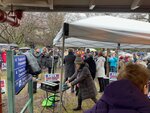A group that hopes to preserve service on the Chestnut Hill West rail line got a boost when the governor proposed a funding increase.
This item is available in full to subscribers.
We have recently launched a new and improved website. To continue reading, you will need to either log into your subscriber account, or purchase a new subscription.
If you are a digital subscriber with an active subscription, then you already have an account here. Just reset your password if you've not yet logged in to your account on this new site.
If you are a current print subscriber, you can set up a free website account by clicking here.
Otherwise, click here to view your options for subscribing.
Please log in to continue |


A group of about 300 Northwest Philadelphians who hope to preserve service on the Chestnut Hill West rail line staged a rally aboard the train itself this weekend, gathering at the Richard Allen Lane station to ride the line into Chestnut Hill on Sunday at 10 a.m.
Then, about an hour before the rally started, the group that calls itself “Save the Train” heard big news. The first step in their plan to keep local lines open amid the current SEPTA funding crisis had already been accomplished: Gov. Josh Shapiro announced that his 2024-25 budget proposal will incorporate a 1.75% increase in the state’s funding for public transit, which should generate $282.8 million for public transportation agencies in Pennsylvania, including SEPTA.
“SEPTA has presented plans to address safety and cleanliness throughout their system, and county officials have entertained a willingness to step up to the plate and increase their support,” Shapiro said in his press release. “As a result, my administration is prepared to make a major investment in SEPTA.”
Anne Dicker, a West Mt. Airy Neighbors board member who helped organize the rally, said Shapiro’s move to close SEPTA’s potential $240 budget shortfall – which needs to be approved by the state legislature – was a good start.
“It’s good that he’s talking about it and being vocal,” she said. “It’s the first hurdle we needed to clear.”
Northwest Philadelphia residents fear the Chestnut Hill West line – and possibly even the Chestnut Hill East line also – could be cut entirely by the transit agency given its relatively low ridership.
If SEPTA fails to close its budget gap, it would almost certainly result in a series of service cuts and fare increases for the transit agency, which has yet to recover from the stress it experienced during Covid. That would lead to decreased ridership, a process known in the industry as a “death spiral,” said SEPTA’s CEO and General Manager Leslie Richards.
Richards previously asked for slightly more than what Shapiro just proposed: $295 million in increased funding for public transportation in Pennsylvania, $190 million of which would have gone to SEPTA.
In his statement, Shapiro’s office recognized that the funding is especially important to the Philadelphia area.
“Governor Shapiro knows that funding for public transit is especially critical in Southeastern Pennsylvania,” read a press release distributed over the weekend. “Over the last several months, the Governor and his Administration have been working closely with SEPTA, the General Assembly, local leadership, and public transit partners to assess their needs and prepare a serious proposal to address them.”
Investing in public transit systems, Shapiro said, “is a commonsense way to create good-paying jobs, spur economic development, and help Pennsylvanians reach their destinations safely.”
He also asked the city’s neighboring counties ”to meet this moment with additional support.”
Shapiro acknowledged that concerns about cleanliness and safety are a major deterrent for many potential riders.
“Pennsylvanians deserve clean, safe, cost-effective ways to travel throughout our cities and towns,” Shapiro said.
A lack of funding is part of that problem. About $17 per taxpayer in Philadelphia’s five-county region goes towards funding for SEPTA, transit advocate Connor Descheemaker, who is the coalition manager for Transit Forward Philly, told the Local. For comparison, that number is, on average, about $70 in Boston, Seattle, Denver, Chicago and Washington, D.C.
“We have an underfunded system that is very efficient for the amount of ground it covers and service it provides,” Descheemaker said.
If the measure is approved, the most recent state estimates project SEPTA to get about $160 million of the $282.8 million, just short of the $190 million Richards said the transit agency needed. It’s unclear how the transit agency would make up the remaining $30 million, although Richards recently told the Philadelphia Business Journal over the weekend that the transit agency could seek revenue through other “innovative” streams – like selling naming rights to some of its stations.
SEPTA will earn approximately $29.1 million throughout the duration of deals it has already struck with various organizations to sponsor four of its stations. Those stations include what was formerly known as Market East and are now Jefferson Station; University City Station, which is now known as Penn Medicine Station; the Market-Frankford Line’s station at 30th Street, which will soon be known as Drexel Station at 30th Street; and NRG Station next to the sports complex in South Philadelphia.
Also included in that $29.1 million figure is a 10-year $5.4 million deal the agency struck for renaming the Media/Elwyn Regional Rail Line, which is now known as the Media/Wawa Line.
Not celebrating yet
Save the Train’s work isn’t anywhere near complete, Dicker said. The governor will still have to negotiate, particularly with Republicans who hold the majority in the state Senate, to get the funding passed in next year’s budget. Lawmakers hope to pass the budget in late June, in time for the state’s 2024-25 fiscal year, which starts July 1.
The deadline is a real concern for Dicker and other public transit advocates, especially since the 2023-24 budget was in a stalemate for months. It didn’t get passed until December.
“I don’t think that CHW is out of the danger zone until that legislation is signed on his desk before the July 1 deadline,” she said.
On the whole, however, Shapiro’s endorsement of increased public transit funding contributed to an encouraging day of rallying for Save the Train, which also used the event as an opportunity to get residents in Northwest Philadelphia excited about taking the train more frequently.
After the rally, the residents who attended the rally caught the 10:50 a.m. train at Mt. Airy’s Richard Allen Lane station and rode it to Chestnut Hill West station. Then they rode the 23 bus along Germantown Avenue back down to Mt. Airy.
“I was shocked at how many people were there,” Dicker said. “Little kids were using the trains for the first time and they had a great time. Even people from Nicetown and East Falls, Germantown and Chestnut Hill – they all came.”
The event was attended by Councilmember Cindy Bass and State Representatives Chris Rabb and Darisha Parker.
“Representatives Parker and Rabb and Councilwoman Bass were extremely vocal about our efforts to save the train,” said Dicker. “That’s what I want to see from Governor Shapiro.”
Before the governor’s announcement, Bass said she’d spoken to SEPTA representatives and asked them whether SEPTA would cut service on the Chestnut Hill West Line completely if the funding wasn’t acquired.
“They wouldn't answer the question directly,” she said. “But if you ask me, I would bet money that this is where they’re heading.”
She also encouraged transit advocates to call Shapiro’s office.
“We need to let them know that this is extremely important,” she said.
Residents are mobilizing
Dicker and other members of the group have circulated a petition to save the train line, which will be sent to Shapiro, to make him aware of the community’s desire to have SEPTA fully funded. As of Monday morning, the petition has more than 6,000 signatures. Dicker’s goal is for the petition to reach 25,000 signatures. To date, the group has raised about $16,000 to pay for lawn signs and other technology that it hopes to use to continue to get the word out.
SEPTA’s Chief Communications Officer Bill Webster, told the Local earlier this month that “nothing has been decided” yet in terms of what could be cut. But he did say that the transit agency would be looking at a 20% cut in service on all modes – not just Regional Rail, but buses, trolleys and the subway – if the funding isn’t procured.
In a statement to the Local, Mayor Cherelle Parker spokesperson Joe Grace said she had been advocating strongly to representatives in Harrisburg, including the governor, to find the money necessary to fully fund SEPTA. Increasing the use of public transit in the city, he added, “is an important part of the long-term vision” for Parker’s first 100 days in office.
The Mayor, “strongly supports public transit for Philadelphians as the best way to get to work, to go to school, and to get around our city,” Grace added.
Local cuts already in effect
On Wednesday, SEPTA announced that the Chestnut Hill East ticket window would be one of 14 ticket windows at Regional Rail stations to close on Feb. 2.
“A wide variety of purchase options available for customers, including SEPTA Key cards and on-board payments, has significantly reduced the number of in-person sales at these locations,” the transit agency said in a press release.
The list of closed ticket windows also includes those at St. Martin’s, Chelten and Carpenter Stations, all of which are along the Chestnut Hill West Line. Mt. Airy Station, which is on the Chestnut Hill East Line, is also on the list.
The lines are also historically significant, Chestnut Hill Conservancy archivist Alex Bartlett said, because they played a significant role in the Northwest’s development. The Chestnut Hill East line, which originally opened in 1832 and was extended to Chestnut Hill in 1854, was run by the Reading Railroad. The Chestnut Hill West Line was opened in 1884 and run by the Pennsylvania Railroad.
“The two railroads together helped turn Chestnut Hill into a city-suburb or community suburb for those working in Center City,” Bartlett said.
Chestnut Hill West has the lowest ridership of any SEPTA Regional Rail Line, not counting the Cynwyd Line, which has only five stops. Another disadvantage, Bartlett said, is that unlike Chestnut Hill East, the line overlaps with some Amtrak property between the Philadelphia Zoo area and 30th Street Station.
“There are frequent scheduling conflicts where Chestnut Hill West Line trains have to wait for Amtrak to pass through,” he said. “SEPTA has to pay some kind of rent for the use of the tracks.”